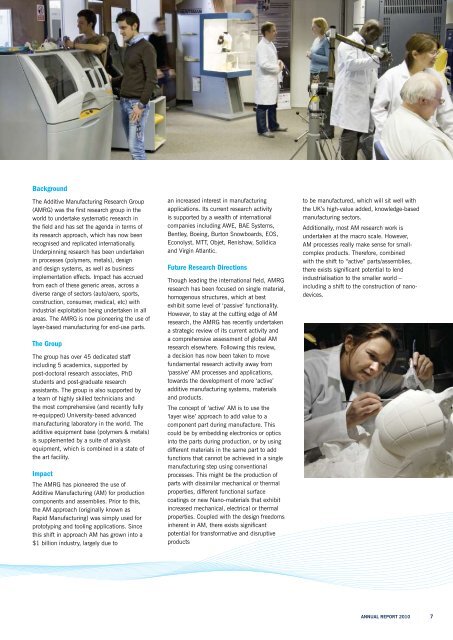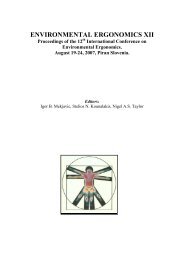ANNUAL REPORT 2010 - Loughborough University
ANNUAL REPORT 2010 - Loughborough University
ANNUAL REPORT 2010 - Loughborough University
Create successful ePaper yourself
Turn your PDF publications into a flip-book with our unique Google optimized e-Paper software.
Background<br />
The Additive Manufacturing Research Group<br />
(AMRG) was the first research group in the<br />
world to undertake systematic research in<br />
the field and has set the agenda in terms of<br />
its research approach, which has now been<br />
recognised and replicated internationally.<br />
Underpinning research has been undertaken<br />
in processes (polymers, metals), design<br />
and design systems, as well as business<br />
implementation effects. Impact has accrued<br />
from each of these generic areas, across a<br />
diverse range of sectors (auto/aero, sports,<br />
construction, consumer, medical, etc) with<br />
industrial exploitation being undertaken in all<br />
areas. The AMRG is now pioneering the use of<br />
layer-based manufacturing for end-use parts.<br />
The group<br />
The group has over 45 dedicated staff<br />
including 5 academics, supported by<br />
post-doctoral research associates, PhD<br />
students and post-graduate research<br />
assistants. The group is also supported by<br />
a team of highly skilled technicians and<br />
the most comprehensive (and recently fully<br />
re-equipped) <strong>University</strong>-based advanced<br />
manufacturing laboratory in the world. The<br />
additive equipment base (polymers & metals)<br />
is supplemented by a suite of analysis<br />
equipment, which is combined in a state of<br />
the art facility.<br />
Impact<br />
The AMRG has pioneered the use of<br />
Additive Manufacturing (AM) for production<br />
components and assemblies. Prior to this,<br />
the AM approach (originally known as<br />
Rapid Manufacturing) was simply used for<br />
prototyping and tooling applications. Since<br />
this shift in approach AM has grown into a<br />
$1 billion industry, largely due to<br />
an increased interest in manufacturing<br />
applications. Its current research activity<br />
is supported by a wealth of international<br />
companies including AWE, BAE Systems,<br />
Bentley, Boeing, Burton Snowboards, EOS,<br />
Econolyst, MTT, Objet, Renishaw, Solidica<br />
and Virgin Atlantic.<br />
Future Research Directions<br />
Though leading the international field, AMRG<br />
research has been focused on single material,<br />
homogenous structures, which at best<br />
exhibit some level of ‘passive’ functionality.<br />
However, to stay at the cutting edge of AM<br />
research, the AMRG has recently undertaken<br />
a strategic review of its current activity and<br />
a comprehensive assessment of global AM<br />
research elsewhere. Following this review,<br />
a decision has now been taken to move<br />
fundamental research activity away from<br />
‘passive’ AM processes and applications,<br />
towards the development of more ‘active’<br />
additive manufacturing systems, materials<br />
and products.<br />
The concept of ‘active’ AM is to use the<br />
‘layer wise’ approach to add value to a<br />
component part during manufacture. This<br />
could be by embedding electronics or optics<br />
into the parts during production, or by using<br />
different materials in the same part to add<br />
functions that cannot be achieved in a single<br />
manufacturing step using conventional<br />
processes. This might be the production of<br />
parts with dissimilar mechanical or thermal<br />
properties, different functional surface<br />
coatings or new Nano-materials that exhibit<br />
increased mechanical, electrical or thermal<br />
properties. Coupled with the design freedoms<br />
inherent in AM, there exists significant<br />
potential for transformative and disruptive<br />
products<br />
to be manufactured, which will sit well with<br />
the UK’s high-value added, knowledge-based<br />
manufacturing sectors.<br />
Additionally, most AM research work is<br />
undertaken at the macro scale. However,<br />
AM processes really make sense for smallcomplex<br />
products. Therefore, combined<br />
with the shift to “active” parts/assemblies,<br />
there exists significant potential to lend<br />
industrialisation to the smaller world –<br />
including a shift to the construction of nanodevices.<br />
AnnuAl RepoRt <strong>2010</strong> 7

















